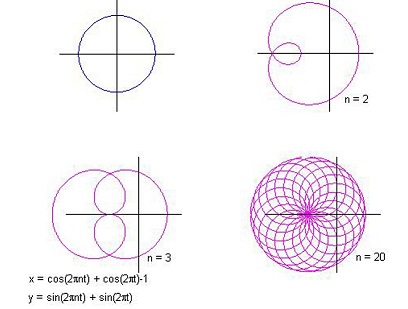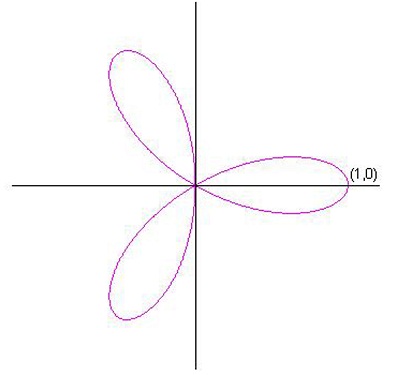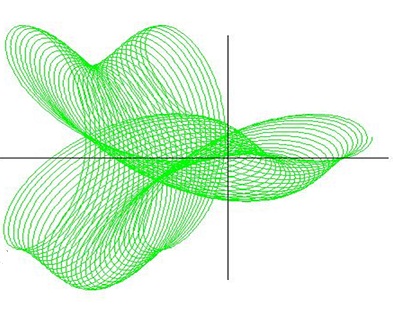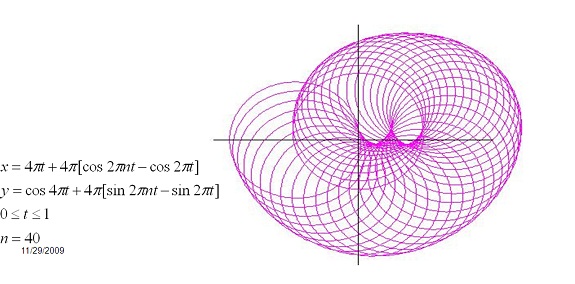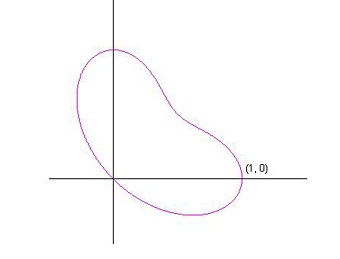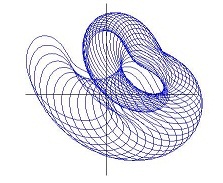n-curve
We take the functional theoretic algebra C[0, 1] of curves. For each loop γ at 1, and each positive integer n, we define a curve [math]\displaystyle{ \gamma_n }[/math] called n-curve.[clarification needed] The n-curves are interesting in two ways.
- Their f-products, sums and differences give rise to many beautiful curves.
- Using the n-curves, we can define a transformation of curves, called n-curving.
Multiplicative inverse of a curve
A curve γ in the functional theoretic algebra C[0, 1], is invertible, i.e.
- [math]\displaystyle{ \gamma^{-1} \, }[/math]
exists if
- [math]\displaystyle{ \gamma(0)\gamma(1) \neq 0. \, }[/math]
If [math]\displaystyle{ \gamma^{*}=(\gamma(0)+\gamma(1))e - \gamma }[/math], where [math]\displaystyle{ e(t)=1, \forall t \in [0, 1] }[/math], then
- [math]\displaystyle{ \gamma^{-1}= \frac{\gamma^{*}}{\gamma(0)\gamma(1)}. }[/math]
The set G of invertible curves is a non-commutative group under multiplication. Also the set H of loops at 1 is an Abelian subgroup of G. If [math]\displaystyle{ \gamma \in H }[/math], then the mapping [math]\displaystyle{ \alpha \to \gamma^{-1}\cdot \alpha\cdot\gamma }[/math] is an inner automorphism of the group G.
We use these concepts to define n-curves and n-curving.
n-curves and their products
If x is a real number and [x] denotes the greatest integer not greater than x, then [math]\displaystyle{ x-[x] \in [0, 1]. }[/math]
If [math]\displaystyle{ \gamma \in H }[/math] and n is a positive integer, then define a curve [math]\displaystyle{ \gamma_{n} }[/math] by
- [math]\displaystyle{ \gamma_n (t)=\gamma(nt - [nt]). \, }[/math]
[math]\displaystyle{ \gamma_{n} }[/math] is also a loop at 1 and we call it an n-curve. Note that every curve in H is a 1-curve.
Suppose [math]\displaystyle{ \alpha, \beta \in H. }[/math] Then, since [math]\displaystyle{ \alpha(0)=\beta(1)=1, \mbox{ the f-product } \alpha \cdot \beta = \beta + \alpha -e }[/math].
Example 1: Product of the astroid with the n-curve of the unit circle
Let us take u, the unit circle centered at the origin and α, the astroid. The n-curve of u is given by,
- [math]\displaystyle{ u_n(t) = \cos(2\pi nt)+ i \sin(2\pi nt) \, }[/math]
and the astroid is
- [math]\displaystyle{ \alpha(t)=\cos^{3}(2\pi t)+ i \sin^{3}(2\pi t), 0\leq t \leq 1 }[/math]
The parametric equations of their product [math]\displaystyle{ \alpha \cdot u_{n} }[/math] are
- [math]\displaystyle{ x=\cos^3 (2\pi t)+ \cos(2\pi nt)-1, }[/math]
- [math]\displaystyle{ y=\sin^{3}(2\pi t)+ \sin(2\pi nt) }[/math]
See the figure.
Since both [math]\displaystyle{ \alpha \mbox{ and } u_{n} }[/math] are loops at 1, so is the product.
Example 2: Product of the unit circle and its n-curve
The unit circle is
- [math]\displaystyle{ u(t) = \cos(2\pi t)+ i \sin(2\pi t) \, }[/math]
and its n-curve is
- [math]\displaystyle{ u_n(t) = \cos(2\pi nt)+ i \sin(2\pi nt) \, }[/math]
The parametric equations of their product
- [math]\displaystyle{ u \cdot u_{n} }[/math]
are
- [math]\displaystyle{ x= \cos(2\pi nt)+ \cos(2\pi t)-1, }[/math]
- [math]\displaystyle{ y =\sin(2\pi nt)+ \sin(2\pi t) }[/math]
See the figure.
Example 3: n-Curve of the Rhodonea minus the Rhodonea curve
Let us take the Rhodonea Curve
- [math]\displaystyle{ r = \cos(3\theta) }[/math]
If [math]\displaystyle{ \rho }[/math] denotes the curve,
- [math]\displaystyle{ \rho(t) = \cos(6\pi t)[\cos(2\pi t) + i\sin(2\pi t)], 0 \leq t \leq 1 }[/math]
The parametric equations of [math]\displaystyle{ \rho_{n}- \rho }[/math] are
- [math]\displaystyle{ x = \cos(6\pi nt)\cos(2\pi nt) - \cos(6\pi t)\cos(2\pi t), }[/math]
- [math]\displaystyle{ y = \cos(6\pi nt)\sin(2\pi nt)-\cos(6\pi t)\sin(2\pi t), 0 \leq t \leq 1 }[/math]
n-Curving
If [math]\displaystyle{ \gamma \in H }[/math], then, as mentioned above, the n-curve [math]\displaystyle{ \gamma_{n} \mbox{ also } \in H }[/math]. Therefore, the mapping [math]\displaystyle{ \alpha \to \gamma_n^{-1}\cdot \alpha\cdot\gamma_n }[/math] is an inner automorphism of the group G. We extend this map to the whole of C[0, 1], denote it by [math]\displaystyle{ \phi_{\gamma_n,e} }[/math] and call it n-curving with γ. It can be verified that
- [math]\displaystyle{ \phi_{\gamma_n ,e}(\alpha)=\alpha + [\alpha(1)-\alpha(0)](\gamma_{n}-1)e. \ }[/math]
This new curve has the same initial and end points as α.
Example 1 of n-curving
Let ρ denote the Rhodonea curve [math]\displaystyle{ r = \cos(2\theta) }[/math], which is a loop at 1. Its parametric equations are
- [math]\displaystyle{ x = \cos(4\pi t)\cos(2\pi t), }[/math]
- [math]\displaystyle{ y = \cos(4\pi t)\sin(2\pi t), 0\leq t \leq 1 }[/math]
With the loop ρ we shall n-curve the cosine curve
- [math]\displaystyle{ c(t)=2\pi t + i \cos(2\pi t),\quad 0 \leq t \leq 1. \, }[/math]
The curve [math]\displaystyle{ \phi_{\rho_{n},e}(c) }[/math] has the parametric equations
- [math]\displaystyle{ x=2\pi[t-1+\cos(4\pi nt)\cos(2\pi nt)], \quad y=\cos(2\pi t)+ 2\pi \cos(4\pi nt)\sin(2\pi nt) }[/math]
See the figure.
It is a curve that starts at the point (0, 1) and ends at (2π, 1).

Example 2 of n-curving
Let χ denote the Cosine Curve
- [math]\displaystyle{ \chi(t) = 2\pi t +i\cos(2\pi t), 0\leq t \leq 1 }[/math]
With another Rhodonea Curve
- [math]\displaystyle{ \rho = \cos(3 \theta) }[/math]
we shall n-curve the cosine curve.
The rhodonea curve can also be given as
- [math]\displaystyle{ \rho(t) = \cos(6\pi t)[\cos (2\pi t)+ i\sin(2\pi t)], 0\leq t \leq 1 }[/math]
The curve [math]\displaystyle{ \phi_{\rho_{n},e}(\chi) }[/math] has the parametric equations
- [math]\displaystyle{ x=2\pi t + 2\pi [\cos( 6\pi nt)\cos(2\pi nt)- 1], }[/math]
- [math]\displaystyle{ y=\cos(2\pi t) + 2\pi \cos( 6\pi nt)\sin(2 \pi nt), 0\leq t \leq 1 }[/math]
See the figure for [math]\displaystyle{ n = 15 }[/math].
Generalized n-curving
In the FTA C[0, 1] of curves, instead of e we shall take an arbitrary curve [math]\displaystyle{ \beta }[/math], a loop at 1. This is justified since
- [math]\displaystyle{ L_1(\beta)=L_2(\beta) = 1 }[/math]
Then, for a curve γ in C[0, 1],
- [math]\displaystyle{ \gamma^{*}=(\gamma(0)+\gamma(1))\beta - \gamma }[/math]
and
- [math]\displaystyle{ \gamma^{-1}= \frac{\gamma^{*}}{\gamma(0)\gamma(1)}. }[/math]
If [math]\displaystyle{ \alpha \in H }[/math], the mapping
- [math]\displaystyle{ \phi_{\alpha_n,\beta} }[/math]
given by
- [math]\displaystyle{ \phi_{\alpha_n,\beta}(\gamma) = \alpha_n^{-1}\cdot \gamma \cdot \alpha_n }[/math]
is the n-curving. We get the formula
- [math]\displaystyle{ \phi_{\alpha_n ,\beta}(\gamma)=\gamma + [\gamma(1)-\gamma(0)](\alpha_{n}-\beta). }[/math]
Thus given any two loops [math]\displaystyle{ \alpha }[/math] and [math]\displaystyle{ \beta }[/math] at 1, we get a transformation of curve
- [math]\displaystyle{ \gamma }[/math] given by the above formula.
This we shall call generalized n-curving.
Example 1
Let us take [math]\displaystyle{ \alpha }[/math] and [math]\displaystyle{ \beta }[/math] as the unit circle ``u.’’ and [math]\displaystyle{ \gamma }[/math] as the cosine curve
- [math]\displaystyle{ \gamma (t) = 4\pi t + i\cos(4\pi t) 0 \leq t \leq 1 }[/math]
Note that [math]\displaystyle{ \gamma (1) - \gamma (0) = 4\pi }[/math]
For the transformed curve for [math]\displaystyle{ n = 40 }[/math], see the figure.
The transformed curve [math]\displaystyle{ \phi_{u_n, u}( \gamma ) }[/math] has the parametric equations
Example 2
Denote the curve called Crooked Egg by [math]\displaystyle{ \eta }[/math] whose polar equation is
- [math]\displaystyle{ r = \cos^3 \theta + \sin^3 \theta }[/math]
Its parametric equations are
- [math]\displaystyle{ x = \cos(2\pi t) (\cos^3 2\pi t + \sin^3 2\pi t), }[/math]
- [math]\displaystyle{ y = \sin(2\pi t) (\cos^3 2\pi t + \sin^3 2\pi t) }[/math]
Let us take [math]\displaystyle{ \alpha = \eta }[/math] and [math]\displaystyle{ \beta = u, }[/math]
where [math]\displaystyle{ u }[/math] is the unit circle.
The n-curved Archimedean spiral has the parametric equations
- [math]\displaystyle{ x = 2\pi t \cos(2\pi t)+ 2\pi [(\cos^3 2\pi nt+\sin^3 2\pi nt) \cos(2\pi nt)- \cos(2\pi t)], }[/math]
- [math]\displaystyle{ y = 2\pi t \sin(2\pi t)+ 2\pi [(\cos^3 2\pi nt)+\sin^3 2\pi nt)\sin(2\pi nt)- \sin(2\pi t)] }[/math]
See the figures, the Crooked Egg and the transformed Spiral for [math]\displaystyle{ n = 20 }[/math].
References
- Sebastian Vattamattam, "Transforming Curves by n-Curving", in Bulletin of Kerala Mathematics Association, Vol. 5, No. 1, December 2008
- Sebastian Vattamattam, Book of Beautiful Curves, Expressions, Kottayam, January 2015 Book of Beautiful Curves
External links
 |


